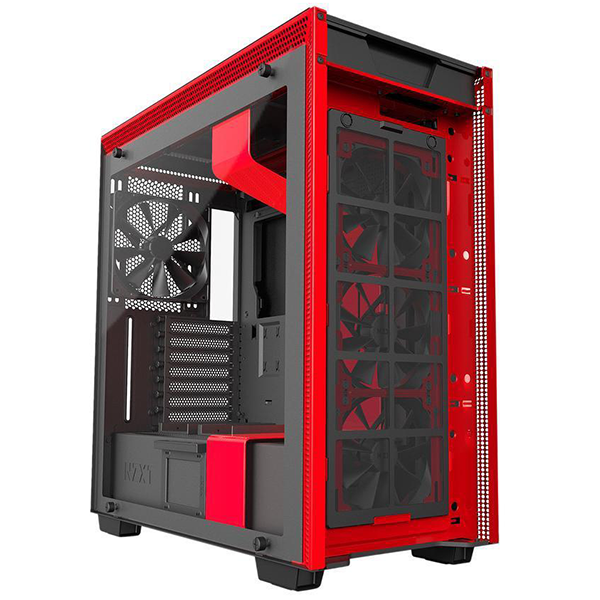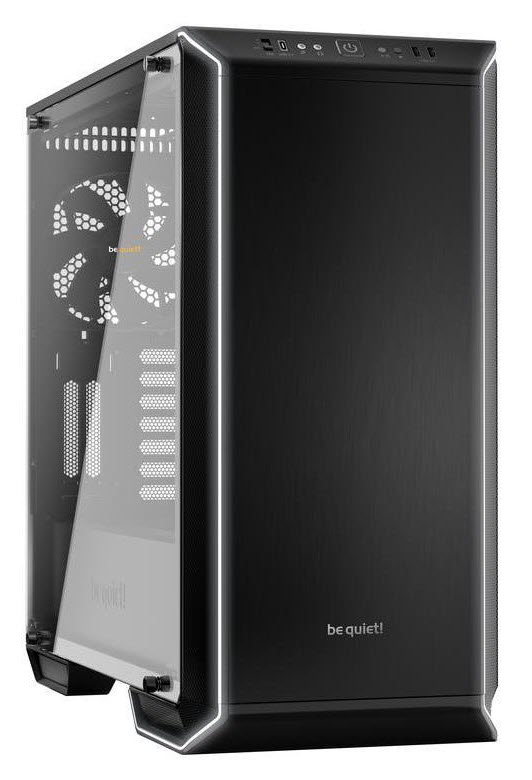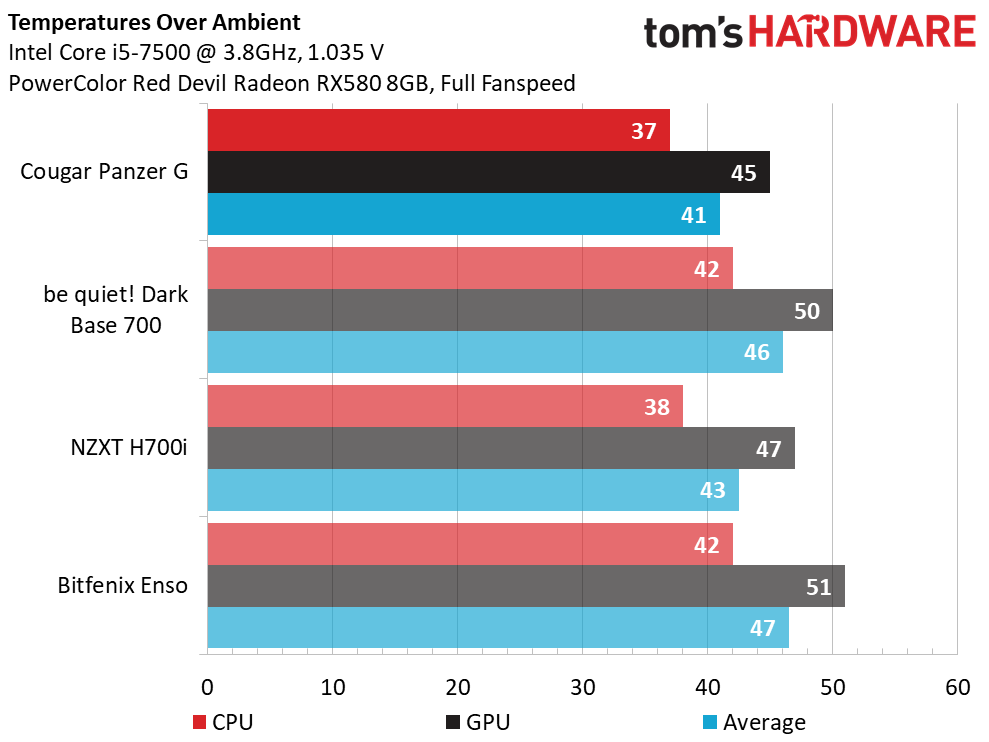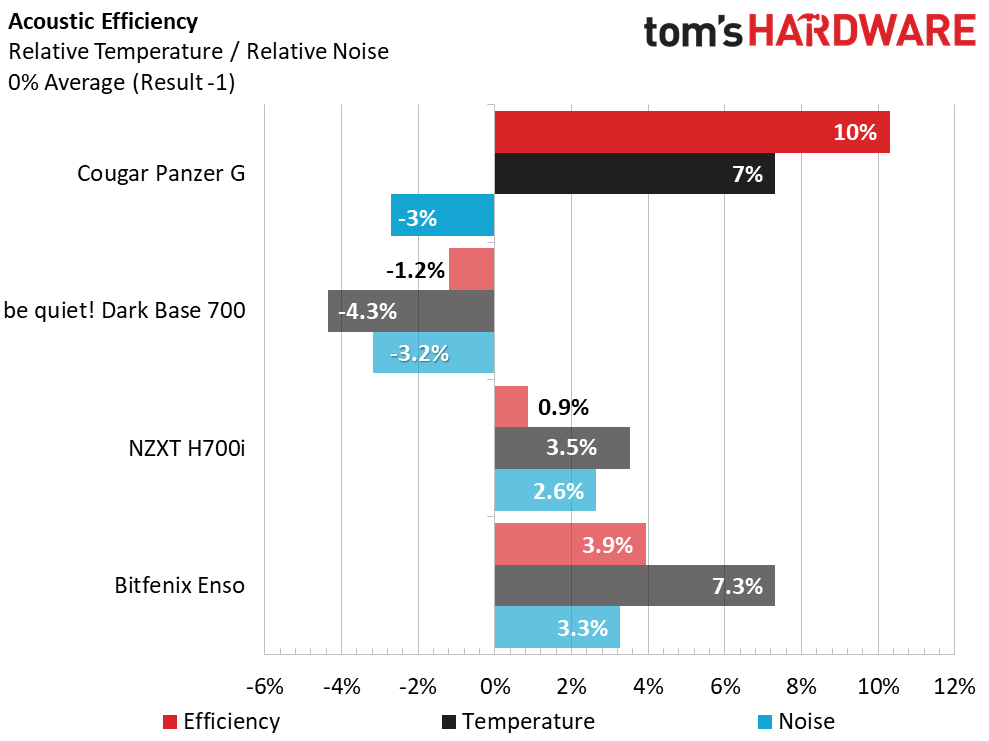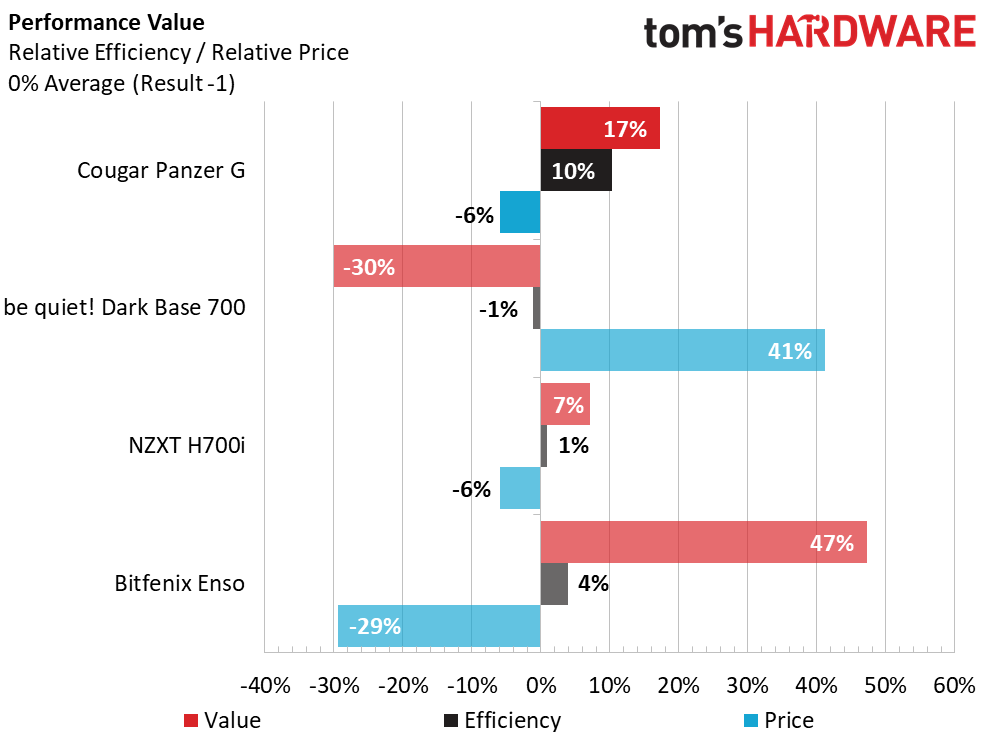Cougar Panzer G Mid-Tower Chassis Review: Good Looks, Great Performance
Why you can trust Tom's Hardware
Testing Results & Conclusion
For the purposes of comparison, we are using the NZXT H700i, the Bitfenix Enso, and the be quiet! Dark Base 700. The cases used for comparison are of similar sizes and feature sets, and all have tempered-glass side panels.
CPU core temperatures on our budget quad-core Core i5-7500 processor running at 3.8GHz were very impressive. With the case's fans set at 1400 RPM, the Cougar Panzer G, thanks in no small part to the generous airflow provided by the triple 120mm intake fans, was more than capable of keeping temperatures in check. Processor temps never exceeded 37°C over the ambient temperature of 25°C. This puts the Panzer G into a tie with Cooler Master's Master Case H500P Mesh chassis and ahead of the NZXT H700i. No easy feat
Graphics-card temperatures fared even better, at 45°C over the ambient, our test GPU turned in the best performance of any of the cases we used for comparison purposes. Obviously this level of heat dissipation can be attributed to the sheer amount of unobstructed airflow, as well as the close proximity of the intake fans to our graphics card. Let's see if all this cooling performance has to come at a cost to acoustic performance.
With tempered glass panels on the front, top and both sides of this chassis, it came as no surprise that system noise was some of the best we have seen. At just 32.2 dBA under load, these results are better than the CMT510, NZXT H700i, and on par with the Dark Base 700. If keeping system noise low is at the top of your list of priorities, you'd be hard-pressed to find a quieter chassis.
Cooling efficiency and noise levels are both ways to measure performance. Determining acoustic efficiency, also referred to as "cooling-to-noise ratio," is a matter of averaging all five of our tests to determine a base value.
The Panzer G offers ticks all the right boxes, including design, functionality and performance. However, even though this chassis is less expensive than direct competitors, we believe a $100 price point would make this a deal you just couldn't pass up. Overall, this is a great case, even at $120.
MORE: Best Cases
Get Tom's Hardware's best news and in-depth reviews, straight to your inbox.
MORE: All Case Content
Current page: Testing Results & Conclusion
Prev Page Hardware Installation & Test ConfigurationSteven Lynch is a contributor for Tom’s Hardware, primarily covering case reviews and news.
-
WildCard999 Odd this didn't earn a TH choice award as it's a really nice case for the price. I would love to see a Gigabyte Aorus motherboard in this case with some orange RGB/LED RAM modules.Reply -
Larmo-Ct I hate to be the "Ugly American" here. But it would be convenient for all of the measurements to be calculated in both millimeters and inches. Also, the whole tempered glass trend in current cases, seems to be a little extreme, and adds weight to the cases. With the way some of the shipping companies handle packages. I shutter to think how some of the glass components will arrive. My older cases have done quite well with transparent plastic sides, not to mention one that has two aluminum sides with no transparency. Lastly, it seems that few, if not none, of the major case manufacturers care that some consumers. Still have optical drives and card readers. So will external drives be the only answer, when a new case is purchased in the future? :-(Reply -
Crashman Reply
I can't even be sure he's actually measuring these rather than repeating factory specs. For years you were treated to actual measurements that included protrusions (such as thumb screws), in both inches and cm, so that you'd be able to tell if it fit your shelf, which was usually measured in inches. And I was personally adding the motherboard depth measurement because so many "EATX" boards are only 10.6", and so many "ATX" cases support more than 10.6". But then we lost a couple motherboard editors, and putting the case reviews into the hands of a different reviewer was the easiest way for me to personally have time to review more motherboards. The new big-case reviewer's methods are slightly different, but he still knows what he's doing, so I ask only that you do your conversions (divide by 25.4 to get inches, for example), forget about squeezing these into tight spaces, and limit your pestering of the author to questions about maximum motherboard depth.20986262 said:I hate to be the "Ugly American" here. But it would be convenient for all of the measurements to be calculated in both millimeters and inches. Also, the whole tempered glass trend in current cases, seems to be a little extreme, and adds weight to the cases. With the way some of the shipping companies handle packages. I shutter to think how some of the glass components will arrive. My older cases have done quite well with transparent plastic sides, not to mention one that has two aluminum sides with no transparency. Lastly, it seems that few, if not none, of the major case manufacturers care that some consumers. Still have optical drives and card readers. So will external drives be the only answer, when a new case is purchased in the future? :-(

